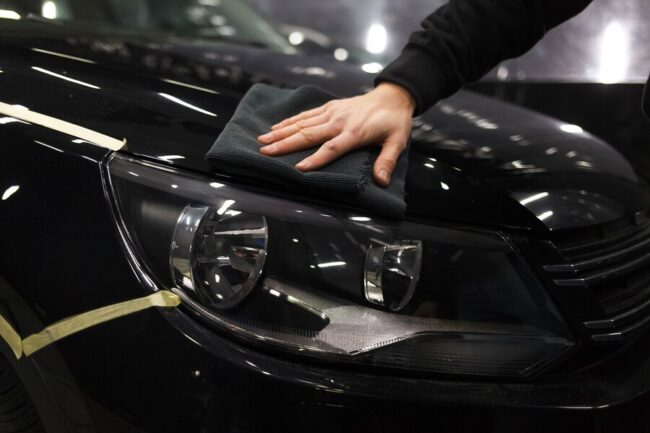Your car’s wheels endure a daily onslaught of dirt, debris, and environmental hazards, all while bearing the weight of your vehicle and providing crucial traction. Traditional methods like waxing and sealants have long been the go-to options to keep them looking pristine and protected from damage. However, a new player in town is revolutionizing how we care for our wheels: ceramic coating.
Ceramic coating offers protection and enhancement beyond what traditional methods can provide. Its advanced formula creates a strong, durable barrier on the surface of your wheels, shielding them from scratches, chips, and the damaging effects of UV rays. This innovative solution not only enhances the appearance of your wheels with a long-lasting glossy finish but also makes maintenance a breeze by repelling dirt, brake dust, and other contaminants.
Join us as we delve into the ceramic coating for wheels, exploring its benefits, application process, and how it’s changing the game for car enthusiasts and professionals alike. Discover why ceramic coating is more than just a trend—it’s a transformative technology here to stay.
Understanding Ceramic Coating
Ceramic coating is a protective layer applied to the exterior surfaces of vehicles, including wheels, to enhance their durability and appearance. It comprises ceramic nanoparticles that form a strong bond with the surface, creating a transparent layer resistant to scratches, chips, and environmental damage. This coating is known for its hydrophobic properties, which repel water and prevent dirt, dust, and grime from sticking to the surface.
Additionally, the ceramic coating provides UV protection, guarding against fading and discoloration caused by prolonged sun exposure. Unlike traditional wax or sealants, ceramic coating offers long-lasting protection, maintaining a glossy finish for an extended period.
Benefits Of Ceramic Coating For Wheels
- Enhanced Durability: Ceramic coating provides a protective layer that shields wheels from scratches, chips, and abrasions, helping them maintain their appearance over time.
- Easy Maintenance: The hydrophobic properties of ceramic coating repel dirt, brake dust, and road grime, making it easier to clean wheels and keep them looking new.
- Long-Lasting Shine: Ceramic coating can maintain a glossy finish for an extended period, reducing the need for frequent polishing or waxing.
- UV Protection: The coating provides a barrier against UV rays, which can cause wheel fading and discoloration, keeping them looking vibrant for longer.
- Chemical Resistance: Ceramic coating is resistant to harsh chemicals, such as acidic cleaners or brake dust removers, helping to preserve the wheel’s finish.
- Heat Resistance: Some ceramic coatings offer heat resistance, which can benefit wheels exposed to high temperatures from braking or intense driving conditions.
Overall, the ceramic coating offers comprehensive protection and aesthetics for wheels, making them more durable and easier to maintain.
Application Process
- Preparation:
-
-
- Start with a clean and dry set of wheels. Remove any existing wax, sealant, or contaminants using a dedicated wheel cleaner and a clay bar if necessary.
- Ensure the wheels are completely dry before proceeding to the next step.
-
- Masking:
-
-
- Use masking tape to cover areas you don’t want to coat, such as tire sidewalls, valve stems, and wheel weights.
-
- Application:
-
-
- Apply a small amount of ceramic coating to an applicator pad or microfiber cloth. Start with a small section of the wheel to ensure even coverage.
- Spread the coating evenly over the surface in a crosshatch pattern, ensuring no missed areas.

- Work one section at a time, such as a spoke or a quarter of the wheel, to ensure thorough coverage without drying out the coating.
-
- Buffing:
-
-
- After applying the coating to a section, gently buff the surface with a clean microfiber towel. This helps to remove any excess product and ensures a smooth finish.
- Continue buffing until the surface feels smooth and there are no streaks or smudges.
-
- Curing:
-
-
- Allow the coating to cure for the recommended time specified by the manufacturer. Depending on the product, this typically ranges from a few minutes to an hour.
- Avoid exposing the coated wheels to water or other contaminants during curing.
-
- Final Inspection:
-
-
- Inspect the wheels under good lighting once the coating is fully cured to ensure uniform coverage and a smooth finish.
- Touch up any areas that may have been missed or require additional coating.
-
- Post-Application Care:
-
- Avoid washing or exposing the wheels to water or harsh chemicals for at least 24-48 hours after application to allow the coating to cure fully.
- Regularly maintain the coated wheels using a pH-neutral wheel cleaner and gentle washing techniques to preserve the coating’s effectiveness.
Steps involved in applying a ceramic coating to wheels
- 1. Prepare the Surface
– Clean the wheels thoroughly to remove dirt, grime, and brake dust. Use a wheel cleaner and a brush to scrub the surface.
– Decontaminate the wheels using a clay bar to remove any embedded contaminants that washing alone might not remove.
- Inspect the Wheels
– Check for any scratches, chips, or imperfections that must be addressed before applying the ceramic coating.
- Mask Off Areas
– Use masking tape to protect areas like tire sidewalls, brake calipers, and any other parts with which you don’t want the ceramic coating to come into contact.
- 4. Apply the Ceramic Coating
– Apply a small amount of ceramic coating onto an applicator pad or cloth.
– Work in small sections, applying the coating in a crosshatch pattern to ensure even coverage.
– Allow the coating to sit on the surface for the specified time (usually a few minutes) to bond with the wheel.
- Buff Off Excess
– Use a clean, dry microfiber towel to remove any excess coating.
– Ensure thorough and even buffing to avoid streaks or uneven application.
- Repeat for Multiple Layers (Optional)
– Some ceramic coatings recommend multiple layers for maximum durability and shine.
– Follow the manufacturer’s instructions regarding the number of layers and curing times between layers.
- Cure the Coating
– Allow the coated wheels to cure for the specified time (often 24-48 hours) without exposure to water or harsh chemicals.
– Avoid driving the vehicle during this curing period to prevent contamination or damage to the coating.
- 8. Final Inspection
– Inspect the wheels for any missed spots or uneven coverage once cured.
– Touch up as needed, following the same application process.
Importance Of Proper Preparation, Including Cleaning And Decontamination
Proper preparation is crucial before applying a ceramic coating to wheels. Cleaning and decontaminating ensure the coating adheres effectively and provides long-lasting protection.
Cleaning removes dirt, dust, and grime that can interfere with bonding. At the same time, decontamination eliminates contaminants like tar, grease, and residue from previous products that could hinder the coating’s performance. These steps not only optimize the adhesion of the ceramic coating but also contribute to a smooth and flawless finish, enhancing the overall appearance of the wheels.
Choosing The Right Ceramic Coating
When selecting a ceramic coating for your wheels, several factors should be considered to ensure you choose the right product for your needs:
- Durability: Look for coatings that offer long-term protection against scratches, chips, and other forms of damage. High-quality ceramic coatings can provide durable protection for several years.
- Gloss Level: Consider the level of gloss you desire for your wheels. Some coatings offer a high-gloss finish, while others provide a more subdued or matte appearance. Choose a coating that matches your aesthetic preferences.
- Ease of Application: Depending on your skill level and preference, you may opt for a ceramic coating that is easy to apply, even for beginners. Some coatings require a professional application for the best results, while others are designed for DIY enthusiasts.
- Hydrophobic Properties: Look for hydrophobic solid coatings that repel water and prevent dirt and grime from sticking to the surface. This feature makes cleaning easier and helps maintain the coating’s appearance.
- UV Protection: UV rays can cause fading and discoloration of wheels over time. Choose a ceramic coating with UV protection to keep your wheels looking vibrant and new.
- Chemical Resistance: Consider the level of chemical resistance offered by the coating. This is especially important if your wheels are exposed to harsh chemicals from road salts, cleaners, or brake dust.
- Brand Reputation: Research the reputation of the brand offering the ceramic coating. Look for reviews and testimonials from other users to gauge the quality and performance of the product.
- Application Method: Some ceramic coatings require multiple layers or specific application techniques for optimal results. Consider your willingness and ability to follow the application instructions carefully.
- Price: While price should not be the sole determining factor, consider the cost of the ceramic coating and its quality and features. Compare prices of different brands to find the best value for your budget.
Considering these factors, you can choose a ceramic coating that meets your needs and ensures long-lasting protection and enhancement for your wheels.
Maintaining Ceramic Coated Wheels
Maintaining ceramic-coated wheels is essential to preserve their protective properties and aesthetic appeal. Regular maintenance involves gentle cleaning to remove dirt, brake dust, and other contaminants that can degrade the coating over time. It’s essential to use pH-neutral or mild cleaning products and avoid harsh chemicals or abrasive cleaning tools that could scratch the coating. Regular washing with a soft sponge or microfiber cloth, followed by drying with a clean towel, helps maintain the coating’s hydrophobic properties and shine. Periodic inspections for any signs of damage or wear are also recommended, and reapplication of the coating may be necessary after a certain period to ensure continued protection.
Tips For Preserving The Coating’s Effectiveness Over Time
To preserve ceramic coating on wheels, use gentle cleaning products and tools, inspect for damage regularly, apply maintenance coats as needed, and protect from harsh sunlight and environmental contaminants.
- Gentle Cleaning: Use pH-neutral or mild cleaning products and soft tools like microfiber cloths or sponges to avoid damaging the coating.
- Regular Inspection: Check your wheels for any signs of damage or wear, such as scratches or chips, and address them promptly to prevent further deterioration.
- Maintenance Coats: Consider applying a maintenance coat of ceramic coating after a certain period to refresh and reinforce the protective layer.
- Avoid Harsh Chemicals: Avoid harsh chemicals and abrasive cleaning methods that can degrade the coating.
- Protection from Sunlight: Park in shaded areas or use wheel covers to protect your wheels from harsh sunlight, which can cause fading and degradation of the coating.
- Environmental Protection: Protect your wheels from environmental contaminants, such as dirt, road grime, and salt, which can degrade the coating over time.
Conclusion
Ceramic coating has revolutionized how we protect and enhance the appearance of our wheels. Its advanced technology offers unparalleled durability, protection against environmental elements, and a stunning finish lasting years. Ceramic coating is a game-changer whether you’re a car enthusiast looking to elevate your vehicle’s aesthetics or a practical driver seeking long-term protection.
With its ability to repel dirt, water, and UV rays, your wheels will maintain their shine and resilience, even in the harshest conditions. Embrace the power of ceramic coating to transform your wheels into a statement of style and durability that stands the test of time.




